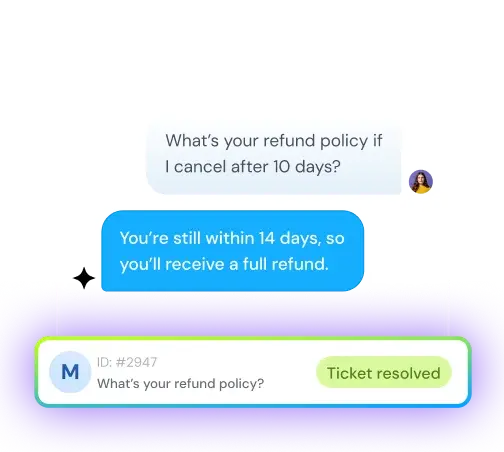8 Steps to build an amazing customer support team in 2025
May 24, 2025

In 2025, support isn’t a back-office function—it’s the heart of business success.
A well-built customer support team doesn’t just solve problems; it strengthens loyalty, boosts retention, and even drives growth. The data speaks volumes—72% of businesses now rank support as their top priority.
But here’s the truth: building an exceptional customer support team takes more than hiring friendly people and giving them scripts. It requires strategy, alignment with company culture, and a deep understanding of what great support looks like today.
After exhaustive research, we’ve distilled the process into 8 proven steps. Whether you're setting up your first customer service team or scaling an existing one, these steps will guide you toward excellence.
Step 1: Define what great customer support means to your business
Before hiring a single agent, define your client support definition. What does “great support” mean for your company?
Modern customers expect fast, personalized, and multi-channel assistance. They want empathy, clarity, and consistency—not just answers.
Here’s how to build that definition:
Set clear service expectations
Your customer support team needs clear goals. Consider:
- Response time – Aim for under four hours. Speed matters.
- Channels – Where do your customers hang out? Support them there.
- Tone of voice – Should your team sound casual, formal, cheerful, or technical?
- Follow-ups – Do you follow up post-resolution? (73% of customers want you to.)
By setting these standards, one retail client increased satisfaction scores by 22%.
Reflect your company values
A customer service team should embody your brand. If innovation is your core value, train agents to find creative solutions. If empathy is key, prioritize emotional intelligence.
A tech consultancy aligned their customer care support services with values like collaboration and forward thinking—and saw NPS scores climb.
Set boundaries
Yes, saying “no” can be part of great support. Define:
- Support hours
- Acceptable channels
- Scope of services
By setting boundaries, one designer reduced burnout and increased client trust. Expectations shape reality.
Step 2: Choose the right support channels
The best customer support teams don’t support every channel—they support the right ones.
Match channels to customer preferences
- Email: Ideal for detailed issues. Still used by 90% of businesses.
- Phone: Offers deep personalization. 76% of users still prefer it for complex issues.
- Live Chat: Efficient and fast. Chat agents can handle 4+ conversations at once.
- Social Media: Great for fast feedback. But comes with high expectations (responses within 1 hour).
Start with one or two channels. Email is a smart foundation. Then scale based on user demand and team readiness.
Create omnichannel consistency
Customers don’t care if they message via Instagram, email, or your website—they just want a unified experience. Equip your customer support team with tools that carry context across channels.
Step 3: Hire the right people for the job
You can’t train empathy. It’s something you hire for. Building a top-tier customer support team means finding people who care.
What to look For
- Empathy: Can they put themselves in the customer’s shoes?
- Communication: Can they explain technical things simply?
- Listening skills: Do they actually hear what the customer says?
Ask questions like:
“Tell me about a time you helped someone under pressure.”
Or try role-play to see them in action.
Define roles clearly
Avoid overlap and confusion by clearly separating tasks:
- First-level agents = common issues
- Senior reps = complex, escalated cases
- Technical support = product or backend issues
Play to strengths—put logical thinkers in troubleshooting roles and patient communicators in billing support.
Use trial tasks
Some of our most successful hiring processes included real-world simulations. Ask candidates to:
- Draft a response to a customer email
- Troubleshoot a mock technical issue
- Role-play a support call
Step 4: Train for real-world scenarios
A great customer support team isn’t born—it’s built through training.
Focus on product knowledge
Agents must know the product inside out. Here’s how to make learning stick:
- Turn training into competitions (gamify it)
- Let agents use the product themselves
- Set up mentorships between veterans and new hires
Knowledgeable reps build trust instantly.
Refine communication
Communication is an essential skill in customer service. Train your customer service team to:
- Use plain, clear language
- Personalize scripts without losing consistency
- Match tone to brand voice
Writing well is an underrated superpower in support.
Role-play and shadowing
Practice makes confident agents. Run exercises like:
- Handling an angry customer
- Walking someone through a technical fix
- Dealing with language or accessibility needs
Let new agents shadow your best performers. You can cut onboarding time by 40% using this method.
Step 5: Equip the right tools and systems
Even the best agents struggle with bad software. Your tools should empower your customer support team, not slow them down.
Helpdesk & ticketing software
Look for features like:
- Unified inbox for all channels
- Customer context (past issues, purchases, chats)
- Collaboration features (internal notes, tagging)
- Automation for assigning, routing, and following up
The right system can cut your response time in half.
Internal tools that boost efficiency
You’d be shocked how much time agents spend on manual tasks. Automate:
- Survey sends after ticket closures
- Order tracking updates
- Repetitive data entry
Also, integrate your helpdesk with your CRM and marketing tools. This gives agents a full view of each customer.
Let your team help choose tools
Your customer support team uses these tools daily. Involve them in decisions:
- Run demos with them
- Gather feedback on usability
- Review tools every 6–12 months
A few seconds saved per ticket = hours saved per week.
Step 6: Build a self-service knowledge base
In 2025, customer support as a service means empowering people to help themselves. And guess what? Customers want that.
Start with FAQs
FAQs are the foundation of your knowledge base. To do it right:
- Use ticket data to choose the top questions
- Write answers that are simple and direct
- Group content logically
- Keep the tone consistent
Good FAQs reduce tickets and increase satisfaction.
Keep it updated
Things change—your knowledge base should too. Update it when:
- You release a new feature
- You change pricing or policies
- You spot rising ticket volume on a topic
Set regular review cycles—monthly or quarterly—to keep content fresh.
Use analytics
Track:
- Which articles are viewed most
- Which searches yield no results
- Article ratings ("Was this helpful?" buttons)
Use this data to fill content gaps and rewrite weak entries.
Step 7: Track the right metrics
Numbers help you guide your customer support team toward greatness. But not all metrics matter equally.
First Response Time (FRT)
Customers hate waiting. Measure how long it takes for your team to respond (not resolve).
Benchmarks:
- Email: Under 24 hours
- Social media: Under 1 hour
- Chat: Instant
Measure in business hours for accuracy.
CSAT (Customer Satisfaction Score)
Send surveys post-resolution. Ask:
"How satisfied were you with your support experience?"
Score = % of responses that are 4 or 5 stars. Aim to achieve an 80%+ CSAT consistently.
Resolution Rate
How many tickets are closed effectively?
Formula: (Resolved tickets / Total tickets) x 100
Low resolution rates often point to knowledge gaps or tool issues.
Step 8: Make support a company-wide priority
Your customer support team doesn’t exist in a vacuum. The best results happen when they collaborate across departments.
Share feedback with product & marketing
Support sees what no one else does. Encourage:
- Weekly feedback meetings with product teams
- Trend reports shared monthly
- Quote sharing to humanize customer needs
Well-shared insights lead to better product decisions and fewer tickets.
Empower reps to make decisions
Nothing kills motivation like micromanagement. Trust agents to:
- Offer refunds or discounts within set limits
- Escalate or close tickets independently
- Suggest process improvements
Empowered reps move faster—and stay longer.
Celebrate the wins
Your customer service team does meaningful work every day. Show appreciation with:
- Public shoutouts in team meetings
- Bonuses for high satisfaction scores
- “Customer Hero” awards
- Team events or even just handwritten thank-you notes
Even better—celebrate Customer Service Week and make it a big deal.
Quick summary: How to build an amazing customer support team in 2025
Support isn’t just about fixing things—it’s about building trust and delivering value.
When you define your vision, hire empathetic people, train them well, and give them the right tools and autonomy, you create something powerful: a customer support team that makes your business unforgettable.
Support is no longer a cost center. It's your competitive edge. Here’s how to build a top-tier customer support team in 2025:
- Define your vision – Align it with company values.
- Choose smart channels – Start small, scale as needed.
- Hire empathetic communicators – Skills can be taught, attitude can't.
- Train for real-life – Simulate, shadow, and practice often.
- Use the right tools – Let your team help choose them.
- Build self-service options – FAQs and knowledge bases reduce load.
- Measure smart metrics – FRT, CSAT, and resolution rate matter.
- Integrate across teams – Share feedback, empower reps, and celebrate wins.
Let your customer support team lead the way to retention, loyalty, and long-term success.
Frequently Asked Questions
Client support means delivering timely, effective, and empathetic help throughout the customer journey. It’s about empowering clients to succeed, not just solving problems.
While often used interchangeably, “customer support team” usually refers to solving post-sale issues, often in tech or SaaS. A “customer service team” can include pre-sales, onboarding, and general customer experience.
Outsource some support functions, invest in self-service tools, and use automation smartly. Focus on one or two strong channels and expand as you grow.
These services include everything from onboarding help, technical support, and live chat to follow-ups and education, at any touchpoint where the company aids its customers.
With product and price no longer being the only differentiators, the customer support team becomes your brand’s human face. They create emotional connections that drive loyalty and revenue.
